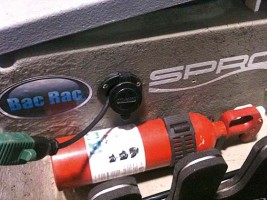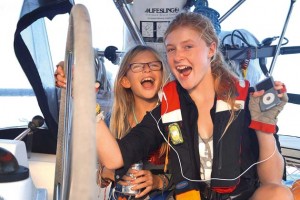Crossing the Atlantic is a huge endeavour, requiring careful preparation. Elaine Bunting gets some advice from skippers who between them have logged more than 45 crossings
What about downwind sails?
Decent sails were mentioned by most of our panel. The subject of which downwind sails are best is a feature in itself, and was covered in detail in a survey earlier this year – see HERE.
Which sails you choose depends on factors such as how highly you rate performance versus easy sailing and so, in turn, on the number of crew. From a racing perspective, says Ross Applebey, ‘reliable downwind sails are a must. We use a Banks Sails 0.9oz runner a great deal.
This is on the light side, but has large head and clew reinforcements, and under IRC four spinnakers makes sense – you have a small penalty versus default three kites, but adding a fifth starts to add a significant rating penalty. I’d say perhaps one light flat A-sail to get moving in non-tradewind conditions, a big runner (say, 0.9oz), a heavy smaller kite (1.5oz AP), and then a heavyish reaching kite (1.5oz A3).’
For Allan Dobson, easy reefing is something he wished he had spent more money on. ‘Given that reefing is on my stress list, I should have spent money on a batten car system, ditched the single line reefing system and fitted the best furlers that money could buy.’
If short-handed and wanting a stress-free crossing there is nothing wrong with wing and wing or twin headsails; both work well.
‘Twin poles that can be rigged together on twin headsails can be priceless for easy sailing,’ says Kurt Lillywhite. ‘I have run a 250-mile day with twin jibs on poles and no mainsail flying, so don’t assume it is a slow option. Twin poles can also make a symmetric spinnaker very stable in lighter rolling conditions and will help you avoid wraps. Sadly twin pole systems are becoming rare with bowsprits and reachers taking over. But remember, in tradewinds dead downwind is often the rhumb line course and sailing angles can mean quartering seas giving an uncomfortable ride.’
‘Really good fire extinguishers are absolutely vital. You are your own fire brigade. Make sure that everyone aboard knows what type of extinguisher to use on a fire, as this is probably the only reason you might ever need the liferaft.’ Stephen Kingsman
Decent sails are pointless, though, without reliable running rigging. ‘New spinnaker halyards are a good idea, and also ensure chafe is not going to be a problem,’ advises Ross Applebey. ‘If you are running halyards through spectacle fittings, ensure they are well aligned and preferably polished. If you see any significant chafe in the course of normal UK racing or cruising, then this is going to be a problem transatlantic. Spinnaker guys take a hammering as well, so inspect the pole beak and ensure it is smooth.’
Paul Redman recommends replacing metal fittings with soft shackles where possible.‘I made up about two dozen Dyneema loops and soft shackles so the only metal to metal contact was at the spinnaker block masthead interface. This was then swapped out to a 15mm Dyneema loop.’
What is the ideal crew?
There are two distinct schools of thought about the strength of crew needed for long offshore passages and transition sailing. Some couples used to cruising together joined occasionally by friends advocate sailing two-handed. Their reasoning is that they have a system with good communication and trust already in place and that continuing it simplifies the provisioning, cooking, cleaning for longer passage and circumvents any interpersonal issues.
Just bear in mind, especially if it is your first Atlantic crossing or the longest non-stop passage to date, that it is likely to be much more tiring than you think. The long watches, continuous rolling motion and any necessary repairs can be extremely wearing. There is a strong argument for taking one or two more people. But it’s not a must, and if you have appropriate redundancies in key equipment such as autopilot and energy charging, two can work fine.
The other camp, indeed the majority of sailors, believes that the experience is best shared with others. As a charter skipper Kurt Lillywhite usually sails with a full crew, and sees its benefits. ‘A transatlantic is two or three weeks at sea and the biggest risk to safety is fatigue. So for any long-distance trip my preferred number aboard is seven.
‘The reasons are very simple: it enables three watches of two (three hours on, six hours off) and a skipper without a formal watch who can always be on call, but be fresh enough to be useful at all times.
‘This watch system keeps everyone fresh and we tend to swap around who is on which watch every three days at midday, so you have someone different to chat with through the night. As people are getting decent sleep, the fact that they may have a double watch on changeover day isn’t an issue.’
‘We often appoint officers for the day, including a Ship’s Enthusiasm Officer whose role is to be enthusiastic about absolutely everything however boring it might be. There are always dull routine jobs and someone has to make them fun. We also have a Daily Entertainments Officer, a seriously important role.’
Stephen Kingsman
Lillywhite says he is not a fan of single-person watches, arguing that ‘the risks go up. Realistically, you cannot do more than trim a sail,’ he argues.
Greater crew numbers allow flexibility on watch systems. ‘We prefer to have two people on watch at a time and always use a rolling watch system so that there are never two new sleepy crew coming on watch in the middle of the night together – this is when accidents and crash gybes inevitably happen. With our system there is always one crew who has been up for an hour or so and is tuned in.
‘The best number for this is five, but it can also work with six and seven. It’s a good idea to keep the skipper out of the watch system if possible so they are free to check weather files, run generators, etc. ‘It’s surprising how many things you can fill your day with, without running a watch as well!’








